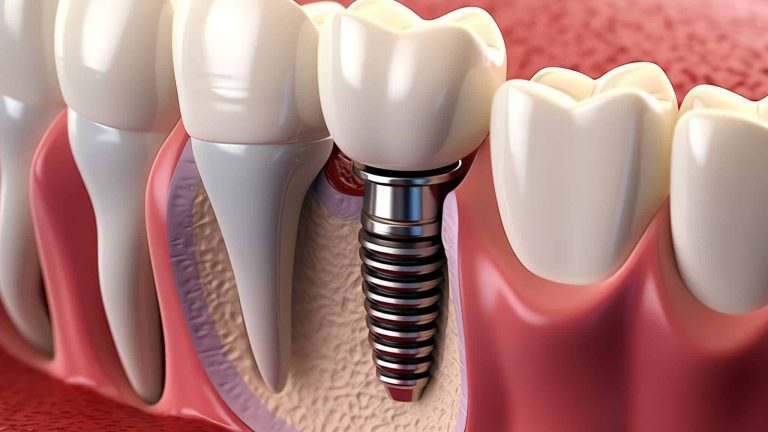The loss of teeth is a situation that many people face throughout their lives. Whether due to cavities, periodontal disease, trauma, or dental wear, losing a tooth can have repercussions that go beyond aesthetics. One of the most serious, though less well-known, effects is bone loss in the jaw. This is where dental implants not only serve the function of replacing missing teeth, but also play a crucial role in preserving the bone structure of the jaw.
What Is Bone Loss and How Does It Occur?
Bone loss in the jaw is a natural process that occurs when the stimulation that teeth provide to the jawbone is absent. Teeth not only serve for chewing but also transfer forces and pressure to the jaw when we eat or speak. This stimulus is essential for maintaining bone density and structure over time.
When a tooth is lost, the transfer of these forces to the jawbone ceases, resulting in bone resorption. Over time, the jaw may experience significant loss in height and width, affecting facial appearance and compromising the stability of adjacent teeth.
How Do Dental Implants Work?
A dental implant is a titanium or zirconium structure surgically placed in the jawbone, replacing the root of the lost tooth. This structure serves as a base for placing a crown, bridge, or prosthesis, allowing the recovery of both dental function and aesthetics.
What sets implants apart from other restorative treatments, such as dentures or traditional bridges, is their ability to fully integrate with the bone through a process called osseointegration. The titanium or zirconium in the implant fuses with the bone, creating a stable and strong foundation that mimics the function of a natural tooth root.
Preventing Bone Loss with Dental Implants
The key to understanding how dental implants help prevent bone loss lies in the process of osseointegration. Unlike bridges or removable dentures, implants act as an artificial root that continues to transmit chewing forces to the jawbone. This stimulus is essential for maintaining bone density and preventing resorption.
When the implant fuses with the bone, it stimulates it similarly to a natural tooth root, helping to preserve bone mass in the area where the tooth was lost. This not only maintains the jaw structure but also helps prevent other issues associated with bone loss, such as the shifting of adjacent teeth and facial collapse.
Effects of Untreated Bone Loss
If tooth loss and consequent bone resorption are not addressed, several long-term issues can occur:
- Facial Changes: Bone loss in the jaw can cause facial structure changes, leading to sunken cheeks and an aged appearance. This is more evident when multiple teeth are missing.
- Difficulty in Placing Prosthetics: When the jawbone has resorbed significantly, it can be more challenging to place implants or prostheses effectively. In some cases, a bone graft may be necessary to regain enough bone structure before proceeding with the implant.
- Instability of Adjacent Teeth: Bone loss also affects the stability of surrounding teeth, which may shift or lose their anchor in the bone.
Benefits of Dental Implants Compared to Other Treatments
- Durability: Dental implants are a permanent solution that can last a lifetime with proper care. Unlike removable dentures, they don’t need to be replaced regularly.
- Stability and Functionality: By integrating directly with the bone, implants provide stability and functionality similar to natural teeth. This allows for comfortable chewing and speaking.
- Preservation of Bone Structure: As mentioned earlier, dental implants are the only tooth replacement devices that prevent bone loss, preserving facial structure and preventing long-term health issues.
- Aesthetics: Dental implants are designed to blend seamlessly with the rest of the teeth, providing a natural appearance and boosting patient confidence.
- Oral Hygiene Maintenance: Unlike dental bridges, which require the adjacent teeth to be shaped, implants do not damage natural teeth. They are also cared for like natural teeth, making good oral hygiene easier to maintain.
The Dental Implant Placement Process
The placement of a dental implant takes place in several stages, starting with an initial evaluation to determine the viability of the procedure. The process is outlined below:
- Initial Evaluation and Planning: The dentist conducts several exams, including X-rays or 3D scans, to assess the amount of bone available and the precise location for implant placement. If there is significant bone loss, a bone graft may be necessary beforehand.
- Implant Placement: A minor surgery is performed under local anesthesia to insert the titanium implant into the jawbone. After surgery, the osseointegration process begins, which can take several months.
- Abutment Placement: Once the implant has fused with the bone, a small connector called an abutment is placed on top of the implant to serve as the base for the dental crown.
- Crown Placement: Finally, a custom-made crown is placed on the abutment, restoring the appearance and function of the lost tooth.
Who Is a Candidate for Dental Implants?
In general, dental implants are a suitable option for anyone who has lost one or more teeth and has enough bone in the jaw to support the implant. However, certain factors can influence a patient’s eligibility:
- Bone Health: Patients with severe bone loss may require additional procedures, such as bone grafts, before the implant can be placed.
- General Health: People with certain health conditions, such as uncontrolled diabetes or heart disease, may not be good candidates for the procedure, as these conditions can affect healing.
- Oral Hygiene: It is essential that patients maintain excellent oral hygiene to ensure the long-term success of the implants.
The Psychological Impact of Restoring a Full Smile
Beyond the functional and health benefits, the placement of dental implants has a significant impact on a patient’s self-esteem and quality of life. Tooth loss is often associated with a loss of confidence, difficulties in speaking and eating, and even social isolation. Restoring a full smile with implants can have a transformative effect on a person’s life, allowing them to enjoy everyday activities again with confidence and security.
Conclusion: Dental Implants as an Investment in Long-Term Health and Well-Being
Dental implants not only provide a high-quality aesthetic solution for tooth loss but are also essential for maintaining bone health and facial structure. By preventing bone loss in the jaw, dental implants protect both function and appearance over the long term, significantly improving the patient’s quality of life.
If you have lost one or more teeth and are looking for a solution that not only restores your smile but also helps preserve your jaw health, dental implants are an option to consider. At Clínicas La Guardia, we have advanced technology and a team of specialists dedicated to providing you with the best dental care. Schedule your appointment today and discover how dental implants can transform your life.



